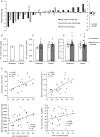Effects of obesity, diabetes and exercise on Fndc5 gene expression and irisin release in human skeletal muscle and adipose tissue: in vivo and in vitro studies
- PMID: 24297848
- PMCID: PMC3948565
- DOI: 10.1113/jphysiol.2013.264655
Effects of obesity, diabetes and exercise on Fndc5 gene expression and irisin release in human skeletal muscle and adipose tissue: in vivo and in vitro studies
Abstract
Irisin was identified as a myokine secreted by contracting skeletal muscle, possibly mediating some exercise health benefits via 'browning' of white adipose tissue. However, a controversy exists concerning irisin origin, regulation and function in humans. Thus, we have explored Fndc5 gene and irisin protein in two clinical studies: (i) a cross-sectional study (effects of type 2 diabetes (T2D) in drug-naive men) and (ii) an intervention study (exercise effects in sedentary, overweight/obese individuals). Glucose tolerance and insulin sensitivity were assessed. Maximal aerobic capacity and muscle strength were measured before and after training. Body composition (magnetic resonance imaging), muscle and liver fat content (1H-magnetic resonance spectroscopy (MRS)) and in vivo muscle metabolism (32P-MRS) were determined. Skeletal muscle and subcutaneous abdominal adipose tissue samples were taken in the fasted state and during euglycaemic hyperinsulinaemia (adipose tissue) and before/after exercise training (muscle). We found that muscle Fndc5 mRNA was increased in prediabetes but not T2D. Fndc5 in adipose tissue and irisin in plasma were reduced in T2D by 40% and 50%, respectively. In contrast, T2D-derived myotubes expressed/secreted the highest levels of Fndc5/irisin. Neither hyperinsulinaemia (adipose tissue/plasma) nor exercise (muscle/plasma) affected Fndc5/irisin in vivo. Circulating irisin was positively associated with muscle mass, strength and metabolism and negatively with fasting glycaemia. Glucose and palmitate decreased Fndc5 mRNA in myotubes in vitro. We conclude that distinct patterns of Fndc5/irisin in muscle, adipose tissue and circulation, and concordant in vivo down-regulation in T2D, indicate that irisin might distinguish metabolic health and disease. Moreover, Fndc5/irisin was discordantly regulated in diabetic muscle and myotubes in vitro, suggesting that whole body factors, such as glucose and fatty acids, might be important for irisin regulation. Exercise did not affect Fndc5/irisin. However, irisin was positively linked to muscle mass, strength and metabolism, pointing to common regulatory factors and/or the potential for irisin to modify muscle phenotype.
Figures

 type 2 diabetic. Data are shown as means ± SEM. *P < 0.05, **P < 0.01, ***P < 0.005.
type 2 diabetic. Data are shown as means ± SEM. *P < 0.05, **P < 0.01, ***P < 0.005.

References
-
- Boström P, Wu J, Jedrychowski MP, Korde A, Ye L, Lo JC, Rasbach KA, Boström EA, Choi JH, Long JZ, Kajimura S, Zingaretti MC, Vind BF, Tu H, Cinti S, Højlund K, Gygi SP, Spiegelman BM. A PGC1–α-dependent myokine that drives brown-fat-like development of white fat and thermogenesis. Nature. 2012;481:463–468. - PMC - PubMed
-
- Brindle KM, Blackledge MJ, Challiss RA, Radda GK. 31P NMR magnetization-transfer measurements of ATP turnover during steady-state isometric muscle contraction in the rat hind limb in vivo. Biochemistry. 1989;28:4887–4893. - PubMed
-
- Choi YK, Kim MK, Bae KH, Seo HA, Jeong JY, Lee WK, Kim JG, Lee IK, Park KG. Serum irisin levels in new-onset type 2 diabetes. Diabetes Res Clin Pract. 2013;100:96–101. - PubMed
Publication types
MeSH terms
Substances
LinkOut - more resources
Full Text Sources
Other Literature Sources
Medical

